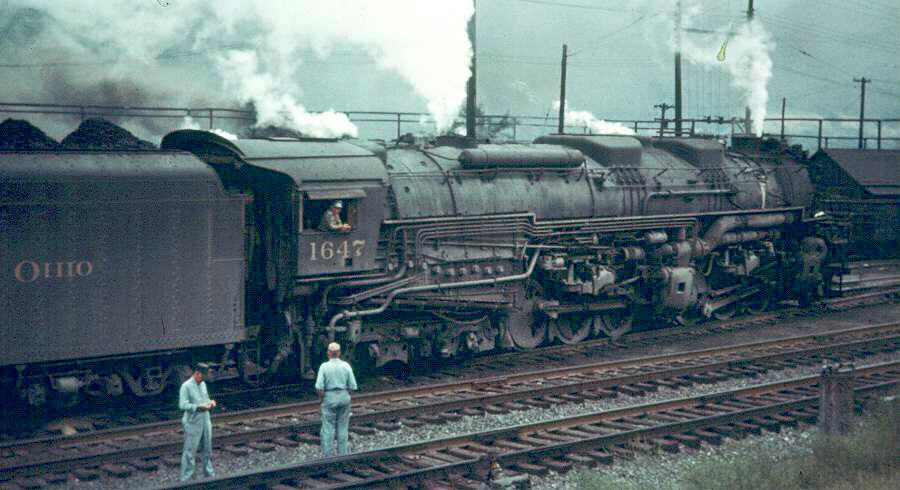

2-6-6-6 Allegheny
In the early 1940s, the Chesapeake & Ohio needed new power on its Allegheny Division to move coal trains over the 80 miles of track from Hinton, WV east to Clifton Forge, VA. This run included a 13 mile .577% grade to the 2,072 foot summit of an Allegheny mountain and then a descent down a 1.14% grade to Clifton Forge. Its 2-6-6-2s were getting old and the 2-8-8-2s, delivered in the 1920s, (which used simple expansion because of tight tunnel clearances) were not up to the task.
In the 1930s, the C&O improved the railroad by boring new tunnels and enlarging others. The Class T-1 "Texas" type 2-10-4s also arrived in the early 1930s and seems to be the choice for the Hinton to Clifton Forge run. On the brink of ordering more 2-10-4s the C&O was approached by the Lima Locomotive Company with a new and more powerful locomotive design.
This design was a six-coupled, single-expansion articulated with 67" diameter drivers for speed, a 9' x 15' firebox with a very large boiler for steaming and 778,000 pounds of locomotive weight to assure tractive effort. The large fire box was placed behind the drivers and required a six-wheel trailing truck to support it. This gave the design a wheel arrangement of 2-6-6-6. With four 22.5" diameter x 33" stroke cylinders, a 260 psi boiler pressure and the 67" diameter drivers it could exert 110,200 pounds of tractive effort.
The C&O placed an order for ten of these 2-6-6-6 locomotives and Lima delivered them in December, 1941. They were designated Class H-8 and assigned road numbers 1600 through 1609. With a new wheel arrangement came a new name. The C&O selected the name "Allegheny" for the mountain range that this new locomotive would do its work.
The tenders for these new locomotives were of the largest type used on the C&O, with a 25,000 gallon water tank and a 25 ton coal bunker. In order to keep the overall length of the locomotive and tender within the limit that existing turntables could handle it was necessary to make the rear section of the tender higher, thus causing more weight to be at the rear than the front. The tender had a six-wheel leading truck, but an eight-wheel trailing truck was needed to carry the weight in the rear.
In operation, one "Allegheny" leading and one pushing could move a 140 car loaded coal train up the mountain from the Hinton terminal. At the top the pusher would be taken off, turned around and sent back to the Hinton terminal. The single leading "Allegheny" could handle the decent down the mountain to Clifton Forge where it would be turned around for a return trip with a train of empty coal cars.
The C&O had 23 of its "Alleghenies" equipped with steam heat and signal lines for passenger service, but they were used sparingly, pulling an occasional heavy mail train or a troop train during World War II. The "Allegheny" may have been the ultimate freight locomotive. They were able to achieve a very impressive record even though they were used in a manner for which they were not designed. The Allegheny boilers were capable of delivering up to 8000 HP! This was far greater than any other reciprocating steam locomotive could develop. However, the C&O used the H-8s in "coal drag" service where they were unable to realize their full potential as high speed locomotives. The C&O Alleghenies were designed to haul 5,000 tons at 45mph, but unfortunately were used to haul trains of 10,000 or more tons at 15mph. C&O's 2-6-6-6s were very impressive locomotives. However, they were never used to their full potential. The "Allegheny" was truly magnificent in its role, but as good as it was it could not win the battle with the diesel. The C&O's "Alleghenies" were taken out of service beginning in 1952 with the last fire dropped in 1956.
The Virginian was the only other railroad to have bought the 2-6-6-6. It took delivery of eight of them in 1945 and used them for hauling coal trains well into the 1950s. On the Virginian these Lima built copies of the C&O "Allegheny" were called "Blue Ridge" type locomotives.
Fortunately, two of the C&O "Allegheny" type locomotives survive today, number 1601 at the Henry Ford Museum in Dearborn, MI and number 1604 at the B&O Railroad Museum in Baltimore, MD.